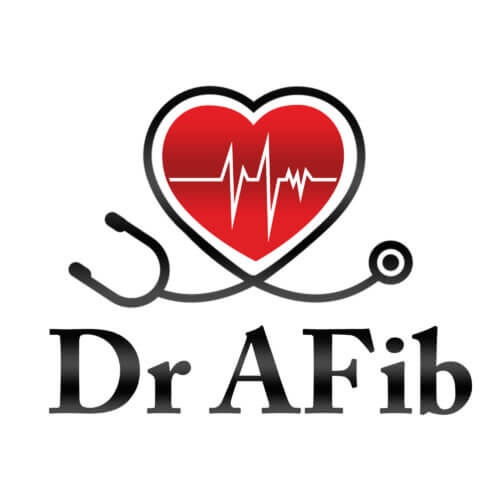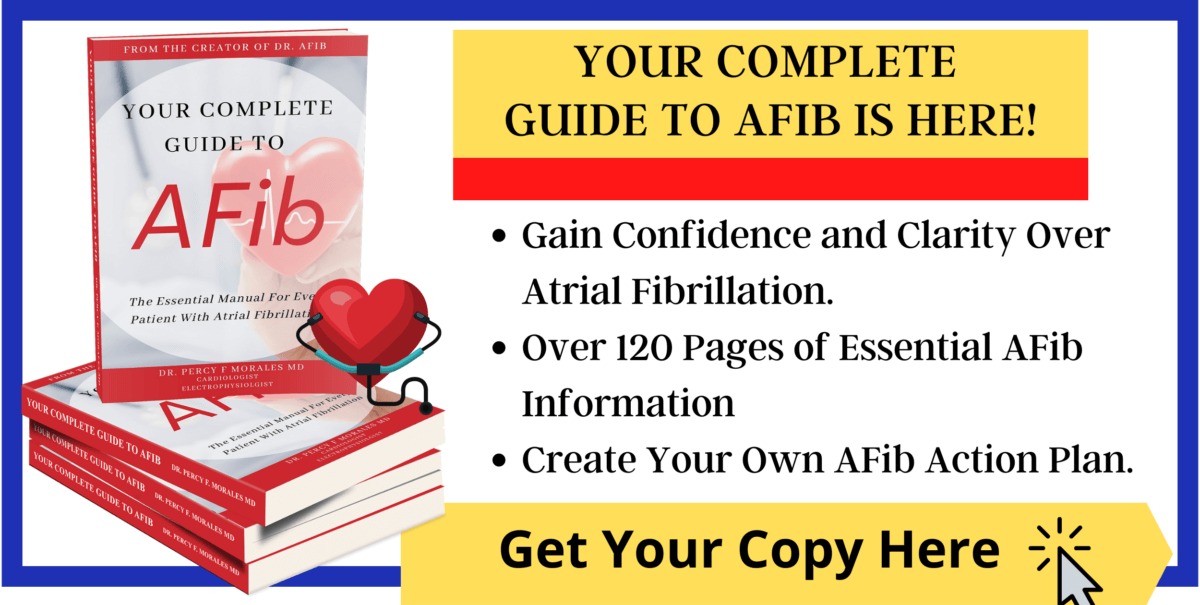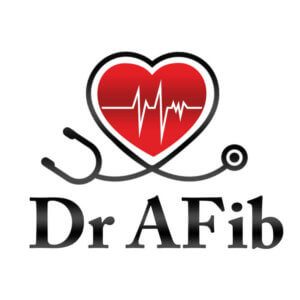Learn more about common AFib medication in this article. Picture this: you or a loved one has just been diagnosed with atrial fibrillation (AFib), and suddenly, you’re bombarded with medical jargon and a handful of medications for AFib. It’s overwhelming, right? You’re not alone. Millions of people experience the same confusion and frustration. But don’t worry – this comprehensive guide is here to help you navigate the world of AFib medications, understand their role in treatment, and ultimately, regain control of your heart health.
In this blog post, we’ll explore the types of medicines for AFib, their purposes, and how they work together to manage your condition. We’ll also discuss the importance of communication with your healthcare team and provide tips for monitoring your treatment progress.
Key Takeaways
Understanding Atrial Fibrillation and its medications is essential to managing AFib risks.
Medications are used to regulate heart rate, restore normal rhythm, and reduce blood clots and stroke risk in patients with AFib.
Regular monitoring of symptoms & side effects as well as communication with your healthcare team should be taken for successful treatment experience.
Understanding Atrial Fibrillation and Its Medications
Atrial fibrillation (AFib) is an irregular and rapid heart rhythm, affecting the upper chambers of the heart, known as the atria. This abnormal heartbeat, in contrast to a normal sinus rhythm, increases the risk of blood clots, which can lead to stroke or heart failure if left untreated. The good news is that there are various medications available to manage AFib and reduce the risks associated with this condition.
The primary goal of AFib medications is to regulate heart rate and rhythm, prevent abnormal heart rhythms, and prevent blood clots from forming. There are several categories of medications used to treat AFib, including anticoagulants, heart rate control medications, and anti-arrhythmic drugs. Each category plays a vital role in treating AFib and ensuring the best possible outcomes for patients.
What is Atrial Fibrillation?
Atrial fibrillation is a type of arrhythmia which affects the heart’s regular rhythm. It is the most common form of arrhythmia. It causes the heart’s upper chambers, the atria, to beat out of sync with the lower chambers, known as ventricles. This chaotic beating pattern can result in AFib symptoms such as:
irregular and rapid heartbeats
shortness of breath
chest pain
fatigue
dizziness
A primary concern with AFib is the increased risk of blood clots forming in the atria. These clots can travel to the brain and block blood flow, leading to a stroke. Managing AFib effectively is key, and this can be achieved through a combination of medications and lifestyle changes that support heart health. In this article, I will focus on common medications used to treat atrial fibrillation.
Your Complete Guide To AFib: The Essential Manual For Every Patient With Atrial Fibrillation
$15.95 (as of May 28, 2025 06:41 GMT -06:00 – More infoProduct prices and availability are accurate as of the date/time indicated and are subject to change. Any price and availability information displayed on [relevant Amazon Site(s), as applicable] at the time of purchase will apply to the purchase of this product.)The Role of Medications in AFib Treatment
Medications play a pivotal role in managing AFib and improving patients’ quality of life. They can help restore a normal heart rhythm and control heart rate, control symptoms, and reduce the frequency and intensity of future AFib episodes.
In addition, anticoagulants, also known as blood thinners, may be prescribed to help prevent blood clots and reduce the risk of stroke. Selecting the most appropriate medication for controlling AFib depends on factors such as the patient’s priorities, the type of AFib present, and personal characteristics like age and other medical conditions or medications.
Working closely with your healthcare team to identify the most suitable treatment options for your specific needs is important.
Categories of AFib Medications
AFib medications can be grouped into three main categories: anticoagulants, heart rate controlling medications, and anti-arrhythmic drugs. Each category serves a distinct purpose in managing AFib and ensuring optimal heart health.
The subsequent sections will provide a deeper insight into each category, discussing their functions and how they contribute to comprehensive AFib treatment.
Understanding the various categories of medications available for AFib treatment will empower you to make informed decisions about your health and collaborate effectively with your healthcare team. With the right combination of medications, you can significantly improve your quality of life and reduce the risks associated with AFib.
AFib Medication: Anticoagulants
Anticoagulants, often referred to as “blood thinners,” are an essential component of AFib treatment for many patients. They work by thinning the blood and preventing the formation of blood clots, which can significantly reduce the risk of stroke in AFib patients. Some of the most commonly prescribed anticoagulants include warfarin and a newer group of drugs called novel oral anticoagulants (NOACs) or also called direct oral anticoagulants (DOACs). Commonly used blood thinning medications include:
Eliquis
Xarelto
Pradaxa
Savaysa
Warfarin
Read more details about blood thinning medications here.
Yet, it should be noted that anticoagulants can increase the risk of internal bleeding, especially in elderly and frail patients or those with certain medical conditions like gastric ulcers. Therefore, it’s crucial to work closely with your healthcare team to determine the most appropriate anticoagulant for your needs and to monitor your treatment progress regularly.
For patients who are unable to tolerate standard blood thinning medications medications, the WATCHMAN can be an excellent procedure based alternative to reduce risk of stroke. Learn more about the WATCHMAN procedure here.
AFib Medication: Heart Rate Controlling Medications
Heart rate controlling medications are another vital component of AFib treatment. Their primary function is to slow down the heart rate, alleviating the symptoms of AFib and reducing the risk of stroke. Common medications used to control heart rate include:
Atenolol
Bisoprolol
Carvedilol
Verapamil
These medications work by targeting various aspects of the electrical conduction system within the heart, ultimately reducing the speed at which the heart beats. Like anticoagulants, consulting with your healthcare team to determine the most suitable heart rate control medication for your specific needs and monitoring your treatment progress is crucial.
AFib Medication: Anti-Arrhythmic Medications
Anti-arrhythmic drugs are the third main category of AFib medications. Their primary role is to restore and maintain a normal heart rhythm, helping to alleviate AFib symptoms and reduce the risk of stroke. These medications can include sodium channel blockers and potassium channel blockers, which target the electrical activity within heart cells to control heart rhythm.
Examples of potassium channel blockers used to treat AFib include dronedarone (Multaq) and sotalol (Betapace). Examples of sodium channel blockers include flecainide and propafenone. While anti-arrhythmic drugs can be effective in controlling heart rhythm, they may also increase the frequency of certain symptoms and potential side effects, so they need to be monitored closely.
Amiodarone Usage for AFib
Amiodarone is a potent anti-arrhythmic medication frequently used in the management of atrial fibrillation (AFib). It works by altering the electrical signals within the heart, helping to restore a normal rhythm and reduce the frequency of AFib episodes. Amiodarone achieves this through a multi-channel blocking mechanism, acting on various ion channels within the heart cells. It inhibits both potassium and sodium channels, slowing down the heart’s electrical conduction system and prolonging the refractory period. This dual action helps to stabilize the heart rhythm, making amiodarone an effective option for many patients with AFib.
However, due to potential side effects, it is typically used when other treatments have not been successful or are not suitable. I typically only use amiodarone for short term treatment options for my patients.
Managing Blood Clot Risks with Medication
Managing blood clot risks is a critical aspect of AFib treatment. As previously mentioned, anticoagulants are the primary medications used to prevent blood clots in AFib patients. However, being aware of the potential risks and precautions associated with blood clot prevention medications is vital to ensure safe and effective treatment.
In this section, we’ll discuss:
The different types of blood thinners
The necessary precautions when taking these medications
Tips for monitoring your treatment progress, as regular check-ups and blood tests are crucial to ensure optimal therapeutic outcomes.
Types of Blood Thinners
Blood thinners can be categorized into two main types: antiplatelets and anticoagulants. Antiplatelets work by inhibiting the normal blood clotting process, thus preventing the formation of clots. Examples of antiplatelet medications include aspirin and clopidogrel. For most patients, antiplatelet medications are not potent enough to reduce risk of stroke compared to anticoagulant medications.
Anticoagulants, on the other hand, work by interfering with the blood clotting process at a protein level, effectively thinning the blood and reducing the risk of clot formation. Examples of anticoagulants include warfarin and novel oral anticoagulants (NOACs) such as eliquis or xarelto.
Working closely with your healthcare team to determine the most appropriate blood thinner for your needs and monitoring your progress is crucial.
Monitoring and Precautions
When taking blood clot prevention medications, it’s vital to follow your healthcare provider’s recommendations and adhere to the prescribed dosage. To ensure optimal dosing and minimize the risk of bleeding complications, regular check-ups and blood tests are necessary. If you experience any unusual bleeding, sudden headaches, or other concerning symptoms, contact your healthcare provider immediately.
Additionally, informing your healthcare team of any other medications or supplements you’re taking is crucial, as certain combinations may increase the risk of bleeding or other complications, by interfering with the metabolism of the blood thinning medication. By maintaining open communication with your healthcare team and following their guidance, you can ensure safe and effective treatment with blood clot prevention medications.
Controlling Heart Rate and Rhythm
In addition to managing blood clot risks, controlling heart rate and rhythm is another crucial aspect of AFib treatment. Various medications, including beta-blockers, calcium channel blockers, and sodium and potassium channel blockers, can help regulate the heart’s rhythm and prevent complications.
In this section, we’ll explore each of these medication categories in more detail, discussing their functions and how they work together to provide comprehensive AFib treatment. By understanding the different medications available for controlling heart rate and rhythm, you can work closely with your healthcare team to develop a tailored treatment plan that best meets your needs.
Beta-Blockers
Beta-blockers are a class of medications commonly used to lower heart rate in AFib patients by inhibiting the effects of certain hormones on the heart and blood vessels. They help reduce blood pressure and heart rate and are effective in managing AFib symptoms. Examples of beta-blockers include metoprolol, atenolol, and bisoprolol.
Although beta-blockers can be beneficial in treating AFib, they may cause side effects such as fatigue, dizziness, and vivid dreams or nightmares. As with all medications, working closely with your healthcare team to monitor your treatment progress and adjust your dosage or medication as needed is crucial.
Calcium Channel Blockers
Calcium channel blockers are another class of commonly used medications used to control heart rate in AFib patients. They work by blocking the influx of calcium into cells, which relaxes the heart and smooths the muscles lining the arteries. As a result, calcium channel blockers help slow down the heart rate and relax arterial muscles, reducing blood pressure and alleviating AFib symptoms.
Some common calcium channel blockers used in AFib treatment include verapamil and diltiazem. Similar to beta-blockers, consulting with your healthcare team to determine the most appropriate calcium channel blocker for your needs and monitoring your treatment progress is important.
Anti-Arrhythmic Medications for AFib
Sodium and potassium channel blockers are another category of medications that can help control heart rhythm in AFib patients. They target the electrical activity within heart cells by inhibiting the function of sodium and potassium channels. As a result, sodium and potassium channel blockers can effectively regulate heart rhythm, reduce AFib symptoms, and restore normal heart rhythm.
Examples of potassium channel blockers used to treat AFib include dronedarone (Multaq) and sotalol (Betapace). Examples of commonly used sodium channel blockers are flecainide and propafenone. Amiodarone and Multaq, other commonly used anti-arrhythmic medications, have multiple effects on sodium and potassium channels. While these medications can be effective in controlling heart rhythm, they may also increase the frequency of certain symptoms and potential side effects.
As always, maintaining close cooperation with your healthcare team to determine the most appropriate sodium and potassium channel blocker for your needs and monitoring your treatment progress is paramount.
AFib Medication: Side Effects and Precautions
Being aware of potential side effects and precautions associated with the various AFib medications is important, as with any medication. In this section, we’ll discuss common side effects and offer tips for managing them effectively.
By understanding the potential side effects of AFib medications and taking appropriate precautions, you can ensure a safe and successful treatment experience.
Common Side Effects of Beta Blockers and Calcium Channel Blockers
Common side effects of beta-blockers, a type of AFib medication, can include fatigue, cold hands and feet, slow heartbeat, and trouble sleeping. Some patients may experience more serious side effects such as shortness of breath, weight gain, or depression. It’s also worth noting that abruptly stopping a beta-blocker can lead to a sudden worsening of AFib symptoms. Therefore, it’s crucial to discuss any side effects with your healthcare provider, who may adjust your dosage or suggest an alternative medication.
Common side effects of calcium channel blockers, which are often used in the treatment of AFib, can include dizziness, flushing, headache, and swelling in the lower legs or feet. Some patients may also experience fatigue, a slow heartbeat, or a rash. More serious side effects, though less common, can include shortness of breath, rapid weight gain, or severe dizziness. As always, it is crucial to discuss any side effects with your healthcare provider who may adjust your dosage or suggest an alternative medication.
Side Effects of Common Anti-Arrhythmic Medications
Anti-arrhythmic medications such as Sotalol, Multaq (dronedarone), and Flecainide play a crucial role in managing atrial fibrillation by helping to restore and maintain a normal heart rhythm. However, they can also come with potential side effects. Common side effects of these drugs may include nausea, dizziness, fatigue, and changes in vision. More serious side effects can include shortness of breath, unexplained weight gain, irregular heartbeat, and severe dizziness. In some cases, these medications may increase the frequency of certain symptoms and potential side effects, and therefore, need to be closely monitored by your healthcare provider. As with all medications, it’s crucial to discuss any side effects with your healthcare provider, who may adjust your dosage or suggest an alternative medication.
Side Effects of Amiodarone
Amiodarone, a potent antiarrhythmic medication, is commonly used in managing atrial fibrillation (AFib). However, it’s important to be aware of its potential side effects. Common side effects of Amiodarone include fatigue, dizziness, tremors, nausea, and vomiting. More serious side effects may include lung or liver damage, visual disturbances, and abnormal thyroid function. It’s also worth noting that Amiodarone can interact with many other medications, potentially leading to further side effects. Therefore, it’s crucial to discuss any side effects with your healthcare provider, who may adjust your dosage or suggest an alternative medication.
Side Effects of Digoxin
Digoxin, a commonly prescribed heart rate control medication, can have several side effects. Patients may experience nausea, vomiting, loss of appetite, and diarrhea. More serious side effects can include confusion, irregular heartbeats, and visual disturbances such as blurred vision or yellow-green halos around objects. It’s important to report any side effects to your healthcare provider, who may adjust your dosage or suggest an alternative medication.
Side Effects of Blood Thinning Medications
Blood thinning medications, such as Eliquis and Xarelto, are crucial in the management of AFib as they help prevent blood clot formation, reducing the risk of stroke. However, these medications can also come with potential side effects. Common side effects of Eliquis and Xarelto may include minor bleeding, such as nosebleeds or bleeding gums, bruising easily, and prolonged bleeding from cuts. These medications can also cause more serious side effects such as severe or uncontrollable bleeding, blood in urine or stools, and coughing up blood.
It’s also important to note that these blood thinners can interact with other medications, supplements, or certain foods, potentially increasing the risk of bleeding or reducing their effectiveness. Therefore, it’s crucial to discuss any side effects with your healthcare provider, who may adjust your dosage or suggest an alternative medication. Regular check-ups and blood tests may be necessary to monitor your treatment progress and ensure the medication’s effectiveness and safety.
Discussing any side effects you experience with your healthcare provider is important, as they may be able to adjust your dosage or recommend an alternate medication to alleviate your symptoms.
Tips for Managing Side Effects
Managing side effects of AFib medications is an important aspect of your treatment journey. Some strategies for managing side effects include taking medications with food, staying hydrated, and avoiding alcohol.
In addition to these strategies, maintaining open communication with your healthcare team and following their guidance regarding your medications and treatment plan is crucial. Keeping a diary of any symptoms or side effects you experience can help you and your healthcare team track your treatment progress and make any necessary adjustments to your medications.
Communicating with Your Healthcare Team
Effective communication with your healthcare team is a key aspect of managing your AFib treatment. By discussing your concerns, asking questions, and providing feedback on your treatment progress, you can work collaboratively with your healthcare team to develop a tailored treatment plan that best meets your needs and goals.
This section will provide some recommended questions to discuss with your doctor about AFib medications and treatment, along with tips for monitoring your treatment progress and maintaining open communication with your healthcare team.
Questions to Ask Your Doctor
When discussing your AFib medications and treatment with your doctor, consider asking the following questions:
Question: What medications are available for the treatment of Atrial Fibrillation? Answer: There are several categories of medications available for AFib treatment, including anticoagulants, heart rate control medications, and antiarrhythmic drugs.
Question: What potential side effects are associated with these medications? Answer: Common side effects of some AFib medications include dizziness, fatigue, nausea, and headaches, among others.
Question: Are there any lifestyle modifications or dietary limitations I should adhere to while taking these medications? Answer: Maintaining a heart-healthy lifestyle, including regular exercise, a nutritious diet, and adequate rest, can help manage side effects and improve treatment outcomes.
Question: What is the duration of my medication regimen? Answer: The duration of your medication regimen will depend on your specific needs and treatment goals, as determined by your healthcare team.
Question: Are there any alternative treatments to medications that you would recommend? Answer: Alternative treatments for AFib may include lifestyle modifications, medical procedures, or other therapies, depending on your specific needs and goals.
Monitoring Your Treatment Progress
Monitoring your treatment progress with AFib medications means:
Keeping track of your progress
Reporting any symptoms, side effects, or concerns to your healthcare team
Regular check-ups, blood tests, and other follow-up tests to ensure that your medications are working effectively and that your treatment plan remains on track.
In addition, keeping a journal of your symptoms and side effects can help you and your healthcare team identify patterns and make any necessary adjustments to your medications.
How Can I Reduce AFib Naturally?
Leading a heart-healthy lifestyle can help reduce AFib naturally and result in less medications. This involves maintaining a balanced diet, rich in fruits, vegetables, lean proteins and whole grains, while limiting intake of saturated fats, cholesterol, sodium, and sugar. Regular physical activity, ideally 30 minutes a day, can also help maintain a healthy weight and lower blood pressure, reducing the risk of AFib. It’s also important to limit alcohol and caffeine, as excessive amounts can trigger an AFib episode.
Additionally, managing stress through relaxation techniques such as yoga, meditation, or deep breathing exercises can help reduce AFib. Adequate sleep is also crucial, as sleep deprivation can increase the risk of AFib. If you have sleep apnea, treating it can significantly reduce AFib episodes. Lastly, quit smoking if you do, as it’s a risk factor for AFib. Remember, while these natural methods can help, they should be used as a complement to, not a substitute for, the treatment plan prescribed by your healthcare provider.
Learn more about natural treatments for AFib here.

Summary
In conclusion, understanding the various medications used to treat atrial fibrillation is essential for managing your condition effectively and optimizing your heart health. By exploring different categories of medications, such as anticoagulants, heart rate control medications, and anti-arrhythmic drugs, you can work closely with your healthcare team to develop a tailored treatment plan that meets your individual needs.
Remember, open communication with your healthcare team, monitoring your treatment progress, and making necessary adjustments to your medications will play a crucial role in your journey towards better heart health. With the right combination of medications and lifestyle modifications, you can successfully manage your AFib and regain control of your life.
Frequently Asked Questions
What is the first drug of choice for atrial fibrillation?
Beta blockers and calcium channel blockers are the common first line drugs of choice for treating atrial fibrillation, as they provide rapid rate control and are effective in reducing the heart rate.
Medications such as metoprolol, bisoprolol or atenolol (beta blockers) and verapamil or diltiazem (calcium channel blockers) may be prescribed, along with digoxin if other drugs are not suitable.
What are the primary goals of AFib medications?
The primary goals of AFib medications are to regulate heart rate and rhythm, prevent abnormal heart rhythms, and prevent blood clots from forming for optimal heart health.
What are the different categories of medications used to treat AFib?
AFib is commonly treated with anticoagulants, heart rate control medications and antiarrhythmic drugs, all of which play a role in managing the condition.
What is the ‘pill in the pocket’ for AFib?
The ‘pill in the pocket‘ approach for AFib refers to taking a dose of an antiarrhythmic medication only at the time of an AFib episode, rather than on a daily basis. This method can be effective for individuals who have infrequent AFib episodes. The specific medication used can vary based on the individual’s health profile and should be determined by a healthcare provider. The most commonly used medication for a pill in the pocket approach is flecainide.
The Best Atrial Fibrillation Book
Your Complete Guide To AFib: The Essential Manual For Every Patient With Atrial Fibrillation
$15.95 (as of May 28, 2025 06:41 GMT -06:00 - More infoProduct prices and availability are accurate as of the date/time indicated and are subject to change. Any price and availability information displayed on [relevant Amazon Site(s), as applicable] at the time of purchase will apply to the purchase of this product.) The A to Z guide on everything you need to know about atrial fibrillation. Written by AFib expert Dr. Percy Morales MD. Over 120 pages of essential information on medications, procedures, and lifestyles modifications for AFib. Easy to read for every patient.
Shop AFib Products on Amazon
KardiaMobile 6-Lead Personal EKG Monitor – Six Views of The Heart – Detects AFib and Irregular Arrhythmias – Instant Results in 30 Seconds – Works with Most Smartphones - FSA/HSA Eligible
13% Off
KardiaMobile 1-Lead Personal EKG Monitor – Record EKGs at Home – Detects AFib and Irregular Arrhythmias – Instant Results in 30 Seconds – Easy to Use – Works with Most Smartphones - FSA/HSA Eligible
$79.00 (as of May 28, 2025 05:51 GMT -06:00 - More infoProduct prices and availability are accurate as of the date/time indicated and are subject to change. Any price and availability information displayed on [relevant Amazon Site(s), as applicable] at the time of purchase will apply to the purchase of this product.)
Apple Watch Series 9 [GPS 41mm] Smartwatch with Storm Blue Aluminum Case with Silver Sport Band M/L. Fitness Tracker, Blood Oxygen & ECG Apps, Always-On Retina Display
(as of May 28, 2025 06:41 GMT -06:00 - More infoProduct prices and availability are accurate as of the date/time indicated and are subject to change. Any price and availability information displayed on [relevant Amazon Site(s), as applicable] at the time of purchase will apply to the purchase of this product.)
Fitbit Sense 2 Advanced Health and Fitness Smartwatch with Tools to Manage Stress and Sleep, ECG App, SpO2, 24/7 Heart Rate and GPS, Shadow Grey/Graphite, One Size (S & L Bands Included)

OMRON 2-in-1 Upper Arm Blood Pressure Monitor & 1-Lead EKG Monitor - Clinically Validated Blood Pressure Arm Cuff & Machine - Use OMRON Connect App
18% Off
Samsung Galaxy Watch 6 44mm Bluetooth Smartwatch, Fitness Tracker, Personalized HR Zones, Advanced Sleep Coaching, Heart Monitor, BIA Sensor, Health Wellness Insights, Big Screen, US Version, Graphite
9% Off
Natural Rhythm Triple Calm Magnesium 150 mg - 120 Capsules – Magnesium Complex Compound Supplement with Magnesium Glycinate, Malate, and Taurate. Calming Blend for Promoting Rest and Relaxation.
$20.77 ($0.17 / Count) (as of May 28, 2025 05:51 GMT -06:00 - More infoProduct prices and availability are accurate as of the date/time indicated and are subject to change. Any price and availability information displayed on [relevant Amazon Site(s), as applicable] at the time of purchase will apply to the purchase of this product.)
Pure Encapsulations Magnesium (Glycinate) - Supplement to Support Stress Relief, Sleep, Heart Health, Nerves, Muscles, and Metabolism* - with Magnesium Glycinate - 180 Capsules
$44.60 ($0.25 / Count) (as of May 28, 2025 06:46 GMT -06:00 - More infoProduct prices and availability are accurate as of the date/time indicated and are subject to change. Any price and availability information displayed on [relevant Amazon Site(s), as applicable] at the time of purchase will apply to the purchase of this product.)
















![Apple Watch Series 9 [GPS 41mm] Smartwatch with Storm Blue Aluminum Case with Silver Sport Band M/L. Fitness Tracker, Blood Oxygen & ECG Apps, Always-On Retina Display #1](https://m.media-amazon.com/images/I/311xwtp4mFL._SL100_.jpg)
![Apple Watch Series 9 [GPS 41mm] Smartwatch with Storm Blue Aluminum Case with Silver Sport Band M/L. Fitness Tracker, Blood Oxygen & ECG Apps, Always-On Retina Display #2](https://m.media-amazon.com/images/I/41j+8AaUGsL._SL100_.jpg)
![Apple Watch Series 9 [GPS 41mm] Smartwatch with Storm Blue Aluminum Case with Silver Sport Band M/L. Fitness Tracker, Blood Oxygen & ECG Apps, Always-On Retina Display #3](https://m.media-amazon.com/images/I/41jIyxZitnL._SL100_.jpg)
![Apple Watch Series 9 [GPS 41mm] Smartwatch with Storm Blue Aluminum Case with Silver Sport Band M/L. Fitness Tracker, Blood Oxygen & ECG Apps, Always-On Retina Display #4](https://m.media-amazon.com/images/I/41IpNJERjCL._SL100_.jpg)
![Apple Watch Series 9 [GPS 41mm] Smartwatch with Storm Blue Aluminum Case with Silver Sport Band M/L. Fitness Tracker, Blood Oxygen & ECG Apps, Always-On Retina Display #5](https://m.media-amazon.com/images/I/31o17yhfYpL._SL100_.jpg)






































